Interaction between Bovine Serum Albumin in Fresh Milk Cream and Encapsulated and Non-Encapsulated Polyphenols of Tamarillo
Abstract
1. Introduction
2. Materials and Methods
2.1. Materials
2.2. Extraction of Tamarillo
2.2.1. Encapsulation of Extracted Tamarillo
2.2.2. Preparation of Fresh Milk Cream Samples with Polyphenols
2.3. Preparation of Standard Solutions
2.4. Spectroscopic Analysis
2.4.1. UV-Visible Absorption Spectroscopy
2.4.2. Fluorescence and Synchronous Fluorescence Spectroscopy
2.5. Physicochemical Properties of Fresh Milk Cream Fortified with Polyphenols
2.5.1. Viscosity
2.5.2. Particle Size
2.5.3. Extraction and Quantification of Phenolics and Anthocyanins
2.5.4. Total Phenolic Content and Antioxidant Capacity
2.6. Statistical Analysis
3. Results
3.1. Spectroscopic Analysis
3.1.1. UV-Visible Absorption Spectroscopy
3.1.2. Fluorescence Spectroscopy
3.1.3. Synchronous Fluorescence Spectroscopy
3.2. Physicochemical Properties of Fresh Milk Cream Fortified with Polyphenols from Tamarillo Extract
3.2.1. Particle Size Distribution
3.2.2. Measurement of Rheological Properties
3.2.3. Phenolic and Anthocyanin Content
3.2.4. Total Phenolic Content (TPC) and Antioxidant Capacity
4. Conclusions
Supplementary Materials
Author Contributions
Funding
Institutional Review Board Statement
Informed Consent Statement
Data Availability Statement
Acknowledgments
Conflicts of Interest
References
- Diep, T.; Pook, C.; Yoo, M. Phenolic and anthocyanin compounds and antioxidant activity of tamarillo (Solanum betaceum Cav.). Antioxidants 2020, 9, 169. [Google Scholar] [CrossRef] [PubMed]
- Calderon-Montano, J.M.; Burgos-Morón, E.; Pérez-Guerrero, C.; López-Lázaro, M. A review on the dietary flavonoid kaempferol. Mini Rev. Med. Chem. 2011, 11, 298–344. [Google Scholar] [CrossRef] [PubMed]
- Gillespie, K.M.; Chae, J.M.; Ainsworth, E.A. Rapid measurement of total antioxidant capacity in plants. Nat. Protoc. 2007, 2, 867–870. [Google Scholar] [CrossRef] [PubMed]
- El-Messery, T.M.; El-Said, M.M.; Demircan, E.; Ozçelik, B. Microencapsulation of natural polyphenolic compounds extracted from apple peel and its application in yoghurt. Acta Sci. Pol. Technol. Aliment. 2019, 18, 25–34. [Google Scholar] [PubMed]
- González, E.; Gómez-Caravaca, A.M.; Giménez, B.; Cebrián, R.; Maqueda, M.; Parada, J.; Martínez-Férez, A.; Segura-Carretero, A.; Robert, P. Role of maltodextrin and inulin as encapsulating agents on the protection of oleuropein during in vitro gastrointestinal digestion. Food Chem. 2020, 310, 125976. [Google Scholar] [CrossRef]
- Gallo, M.; Vinci, G.; Graziani, G.; De Simone, C.; Ferranti, P. The interaction of cocoa polyphenols with milk proteins studied by proteomic techniques. Food Res. Int. 2013, 54, 406–415. [Google Scholar] [CrossRef]
- Hasni, I.; Bourassa, P.; Hamdani, S.; Samson, G.; Carpentier, R.; Tajmir-Riahi, H.A. Interaction of milk α-and β-caseins with tea polyphenols. Food Chem. 2011, 126, 630–639. [Google Scholar] [CrossRef]
- Yu, X.; Cai, X.; Luo, L.; Wang, J.; Ma, M.; Wang, M.; Zeng, L. Influence of tea polyphenol and bovine serum albumin on tea cream formation by multiple spectroscopy methods and molecular docking. Food Chem. 2020, 333, 127432. [Google Scholar] [CrossRef]
- Piovesana, A.; Noreña, C.P.Z. Microencapsulation of bioactive compounds from hibiscus calyces using different encapsulating materials. Int. J. Food Eng. 2018, 14, 20170170. [Google Scholar] [CrossRef]
- Wang, X.; Kristo, E.; LaPointe, G. Adding apple pomace as a functional ingredient in stirred-type yogurt and yogurt drinks. Food Hydrocoll. 2020, 100, 105453. [Google Scholar] [CrossRef]
- Xiao, J.; Chen, X.; Zhang, L.; Talbot, S.G.; Li, G.C.; Xu, M. Investigation of the mechanism of enhanced effect of EGCG on huperzine A’s inhibition of acetylcholinesterase activity in rats by a multispectroscopic method. J. Agric. Food Chem. 2008, 56, 910–915. [Google Scholar] [CrossRef] [PubMed]
- Li, S.; Huang, K.; Zhong, M.; Guo, J.; Wang, W.Z.; Zhu, R. Comparative studies on the interaction of caffeic acid, chlorogenic acid and ferulic acid with bovine serum albumin. Spectrochim. Acta Part A Mol. Biomol. Spectrosc. 2010, 77, 680–686. [Google Scholar] [CrossRef] [PubMed]
- Teng, Y.; Liu, R.; Li, C.; Xia, Q.; Zhang, P. The interaction between 4-aminoantipyrine and bovine serum albumin: Multiple spectroscopic and molecular docking investigations. J. Hazard. Mater. 2011, 190, 574–581. [Google Scholar] [CrossRef]
- Zhang, Y.Z.; Zhou, B.; Zhang, X.P.; Huang, P.; Li, C.H.; Liu, Y. Interaction of malachite green with bovine serum albumin: Determination of the binding mechanism and binding site by spectroscopic methods. J. Hazard. Mater. 2009, 163, 1345–1352. [Google Scholar] [CrossRef] [PubMed]
- Zhang, J.; Chen, L.; Zeng, B.; Kang, Q.; Dai, L. Study on the binding of chloroamphenicol with bovine serum albumin by fluorescence and UV–vis spectroscopy. Spectrochim. Acta Part A Mol. Biomol. Spectrosc. 2013, 105, 74–79. [Google Scholar] [CrossRef] [PubMed]
- Zhang, Y.; Peng, M.; Liu, L.; Shi, S.; Peng, S. Screening, identification, and potential interaction of active compounds from Eucommia ulmodies leaves binding with bovine serum albumin. J. Agric. Food Chem. 2012, 60, 3119–3125. [Google Scholar] [CrossRef]
- Ni, Y.; Wang, S.; Kokot, S. Spectrometric study of the interaction between Alpinetin and bovine serum albumin using chemometrics approaches. Anal. Chim. Acta 2010, 663, 139–146. [Google Scholar] [CrossRef]
- Luo, H.; Li, C.; Fang, H.; Wang, X. Comparative study of the interactions between bisphenol analogues and serum albumins by electrospray mass spectrometry and fluorescence spectroscopy. Rapid Commun. Mass Spectrom. 2016, 30, 162–167. [Google Scholar] [CrossRef]
- Lang, Y.; Li, E.; Meng, X.; Tian, J.; Ran, X.; Zhang, Y.; Zang, Z.; Wang, W.; Li, B. Protective effects of bovine serum albumin on blueberry anthocyanins under illumination conditions and their mechanism analysis. Food Res. Int. 2019, 122, 487–495. [Google Scholar] [CrossRef]
- Skrt, M.; Benedik, E.; Podlipnik, Č.; Ulrih, N.P. Interactions of different polyphenols with bovine serum albumin using fluorescence quenching and molecular docking. Food Chem. 2012, 135, 2418–2424. [Google Scholar] [CrossRef]
- Latruffe, N.; Menzel, M.; Delmas, D.; Buchet, R.; Lançon, A. Compared binding properties between resveratrol and other polyphenols to plasmatic albumin: Consequences for the health protecting effect of dietary plant microcomponents. Molecules 2014, 19, 17066–17077. [Google Scholar] [CrossRef]
- Saha, S.; Chowdhury, J. Binding interaction of Juglone with lysozyme: Spectroscopic studies aided by in silico calculations. J. Photochem. Photobiol. B Biol. 2019, 193, 89–99. [Google Scholar] [CrossRef] [PubMed]
- Gassi, J.Y.; Famelart, M.H.; Lopez, C. Heat treatment of cream affects the physicochemical properties of sweet buttermilk. Dairy Sci. Technol. 2008, 88, 369–385. [Google Scholar] [CrossRef][Green Version]
- Panchal, B.; Bhandari, B. Butter and Dairy Fat Spreads. In Dairy Fat Products and Functionality, 1st ed.; Truong, T., Lopez, C., Bhandari, B., Prakash, S., Eds.; Springer: Cham, Switzerland, 2020; pp. 509–532. [Google Scholar]
- Yildirim-Elikoglu, S.; Erdem, Y.K. Interactions between milk proteins and polyphenols: Binding mechanisms, related changes, and the future trends in the dairy industry. Food Rev. Int. 2018, 34, 665–697. [Google Scholar] [CrossRef]
- Balasubramani, P.; Palaniswamy, P.T.; Visvanathan, R.; Thirupathi, V.; Subbarayan, A.; Maran, J.P. Microencapsulation of garlic oleoresin using maltodextrin as wall material by spray drying technology. Int. J. Biol. Macromol. 2015, 72, 210–217. [Google Scholar] [CrossRef] [PubMed]
- Rajabi, H.; Ghorbani, M.; Jafari, S.M.; Mahoonak, A.S.; Rajabzadeh, G. Retention of saffron bioactive components by spray drying encapsulation using maltodextrin, gum Arabic and gelatin as wall materials. Food Hydrocoll. 2015, 51, 327–337. [Google Scholar] [CrossRef]
- Premi, M.; Sharma, H.K. Effect of different combinations of maltodextrin, gum arabic and whey protein concentrate on the encapsulation behavior and oxidative stability of spray dried drumstick (Moringa oleifera) oil. Int. J. Biol. Macromol. 2017, 105, 1232–1240. [Google Scholar] [CrossRef]
- Tuan, P.M.; Anh, H.T.V.; Cam, L.T.H.; Chi, V.N.Q.; Oanh, D.T.B.; Khue, D.B.; Minh, P.D.T.; Tri, M.H.; Sang, N.T.T.; Mai, D.S.; et al. Extraction and encapsulation of polyphenols from guava leaves. Ann. Food Sci. Technol. 2016, 17, 34–40. [Google Scholar]
- Muangrat, R.; Ravichai, K.; Jirarattanarangsri, W. Encapsulation of polyphenols from fermented wastewater of Miang processing by freeze drying using a maltodextrin/gum Arabic mixture as coating material. J. Food Process. Preserv. 2019, 43, e13908. [Google Scholar] [CrossRef]
- Özyürek, M.; Güçlü, K.; Apak, R. The main and modified CUPRAC methods of antioxidant measurement. TrAC Trends Anal. Chem. 2011, 30, 652–664. [Google Scholar] [CrossRef]
- Semenova, M.G.; Zelikina, D.V.; Antipova, A.S.; Martirosova, E.I.; Grigorovich, N.V.; Obushaeva, R.A.; Shumilina, E.A.; Ozerova, N.S.; Palmina, N.P.; Maltseva, E.L.; et al. Impact of the structure of polyunsaturated soy phospholipids on the structural parameters and functionality of their complexes with covalent conjugates combining sodium caseinate with maltodextrins. Food Hydrocoll. 2016, 52, 144–160. [Google Scholar] [CrossRef]
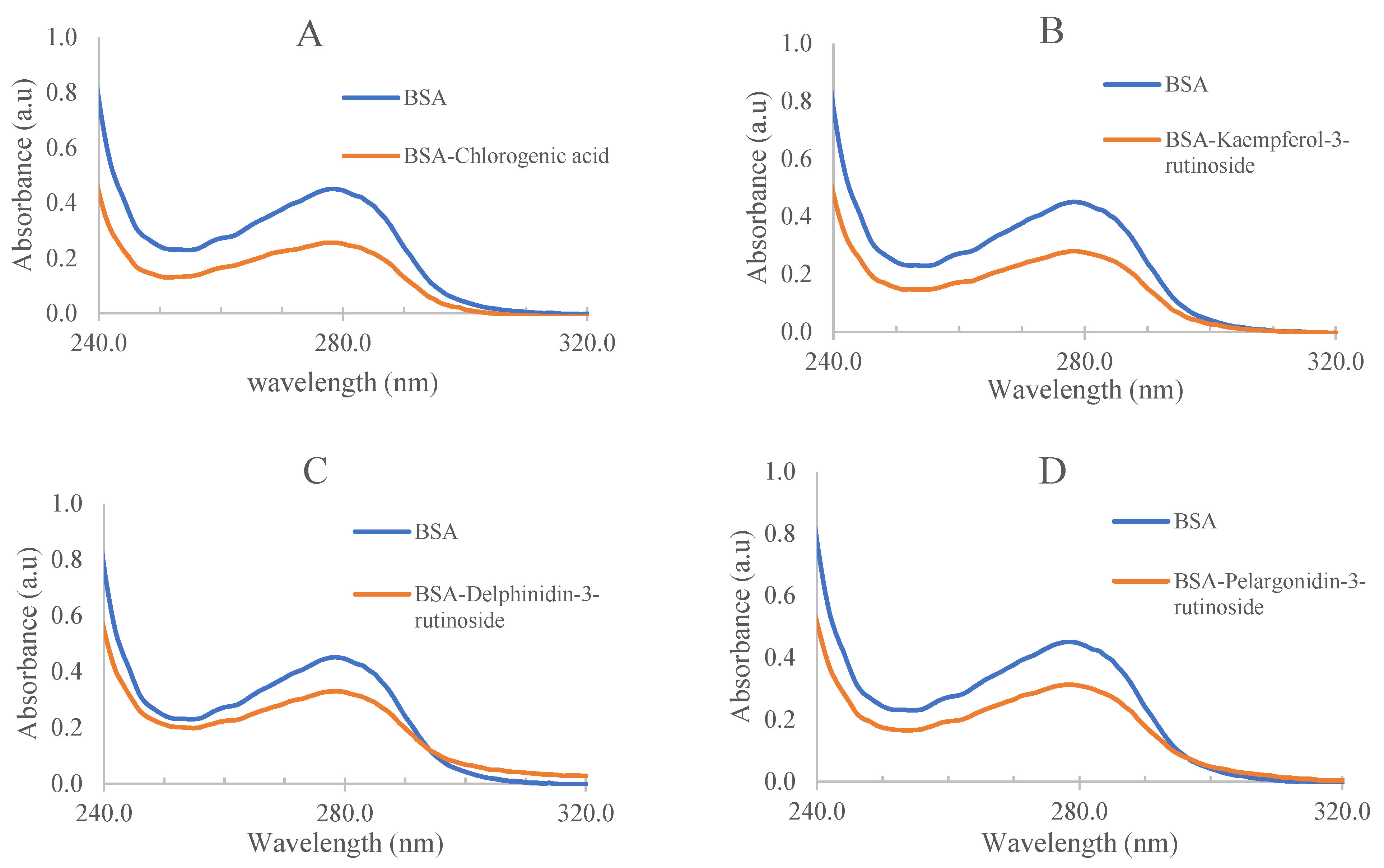

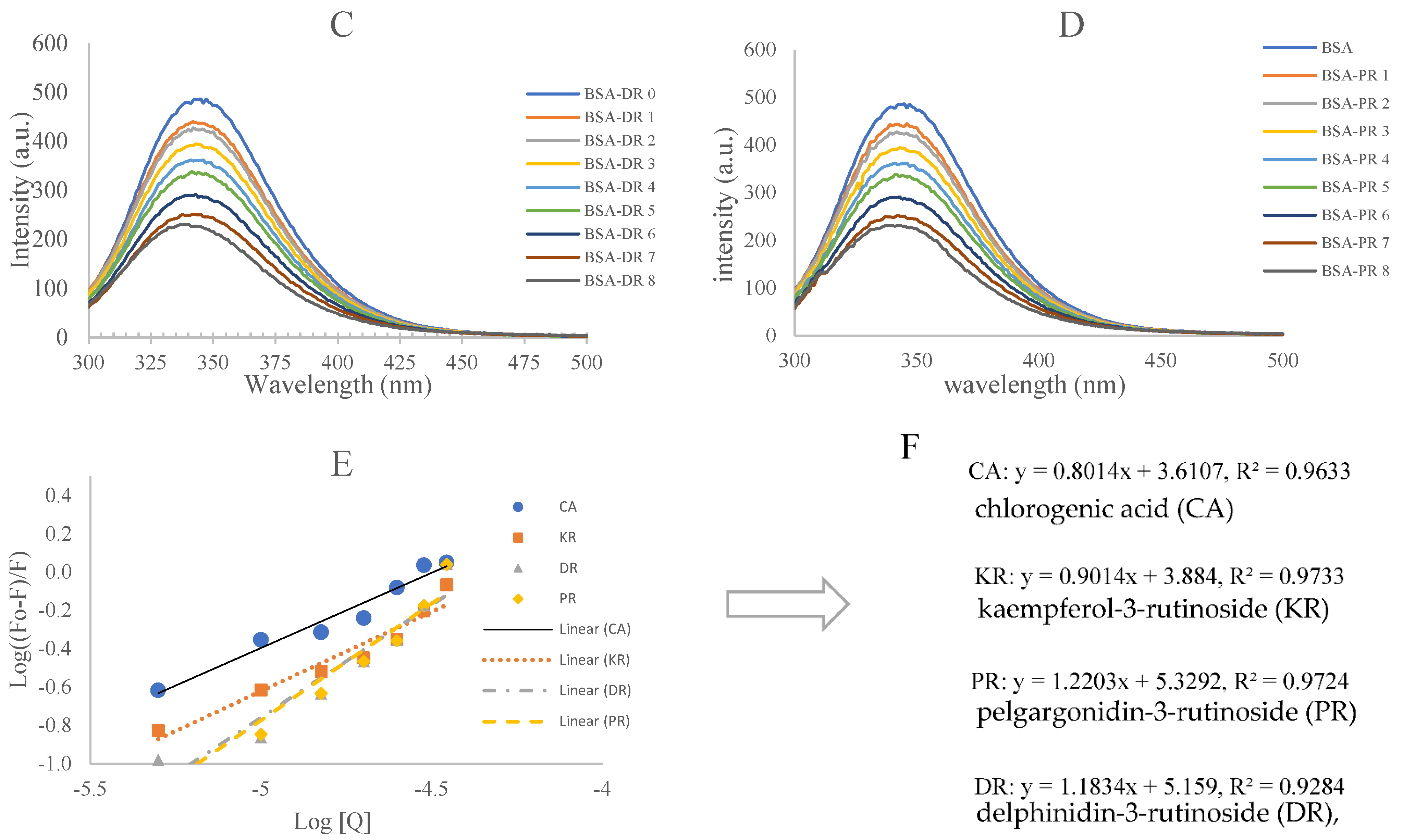

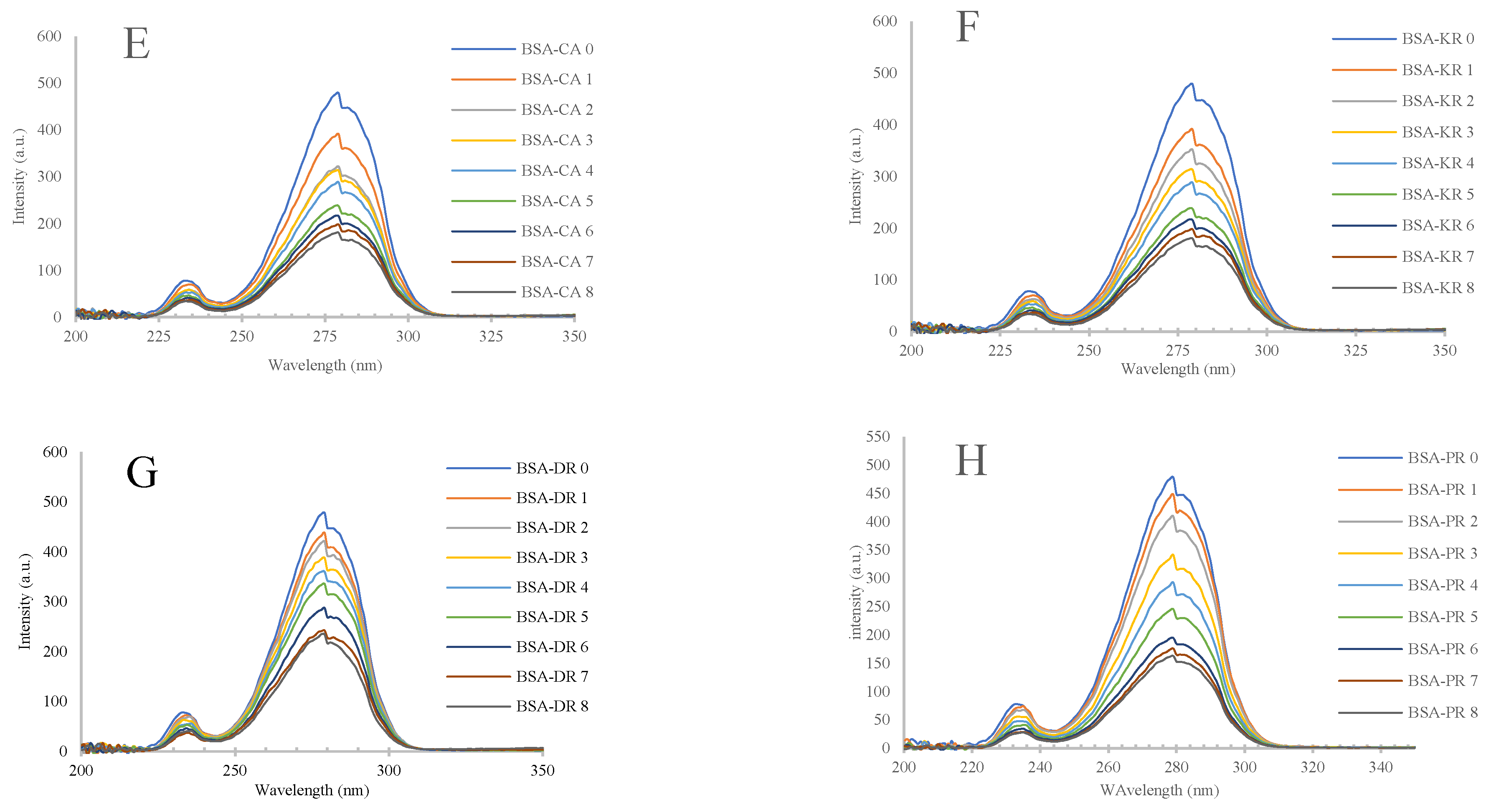
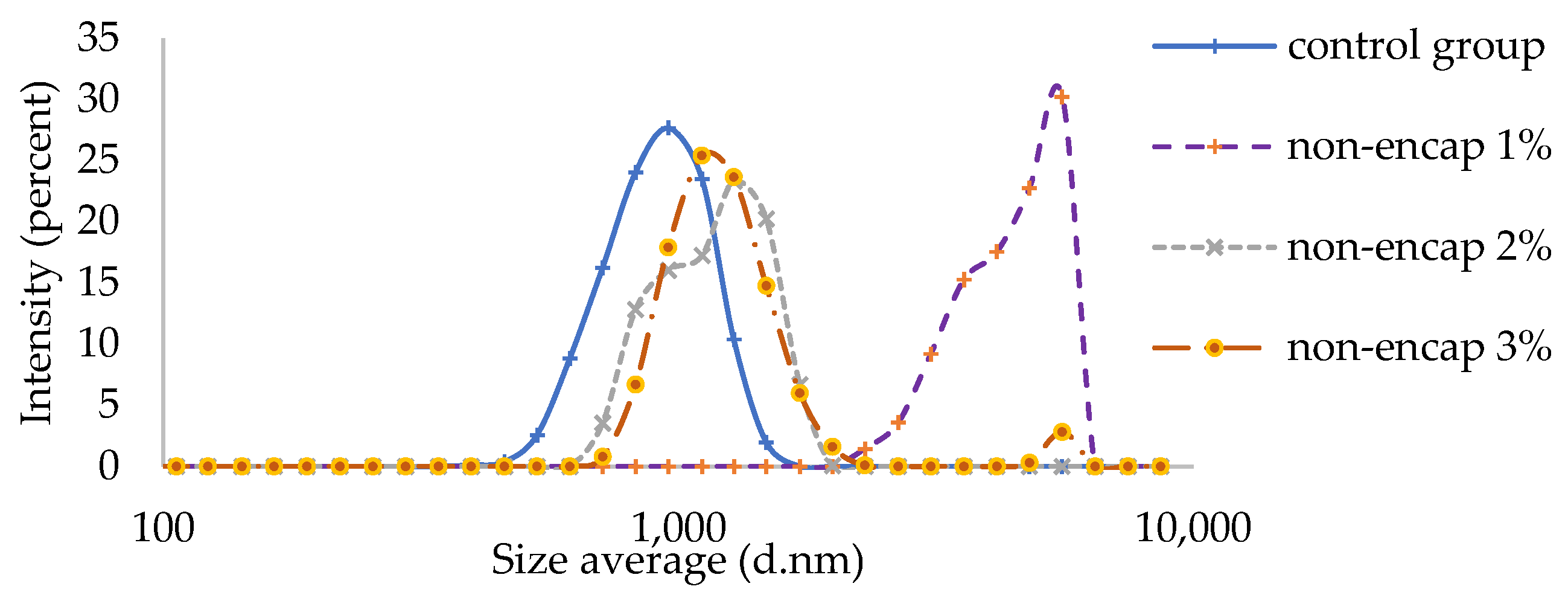
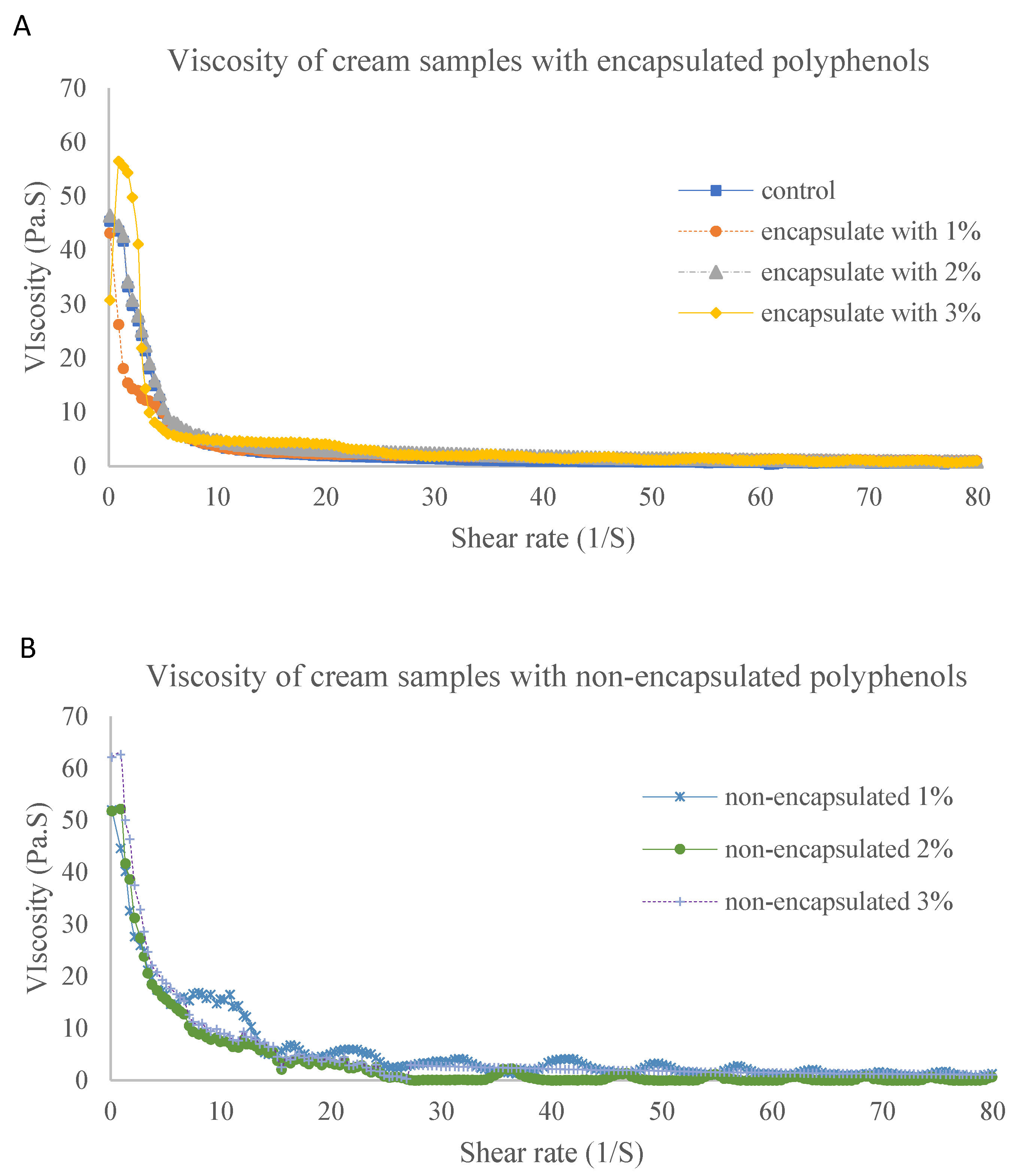
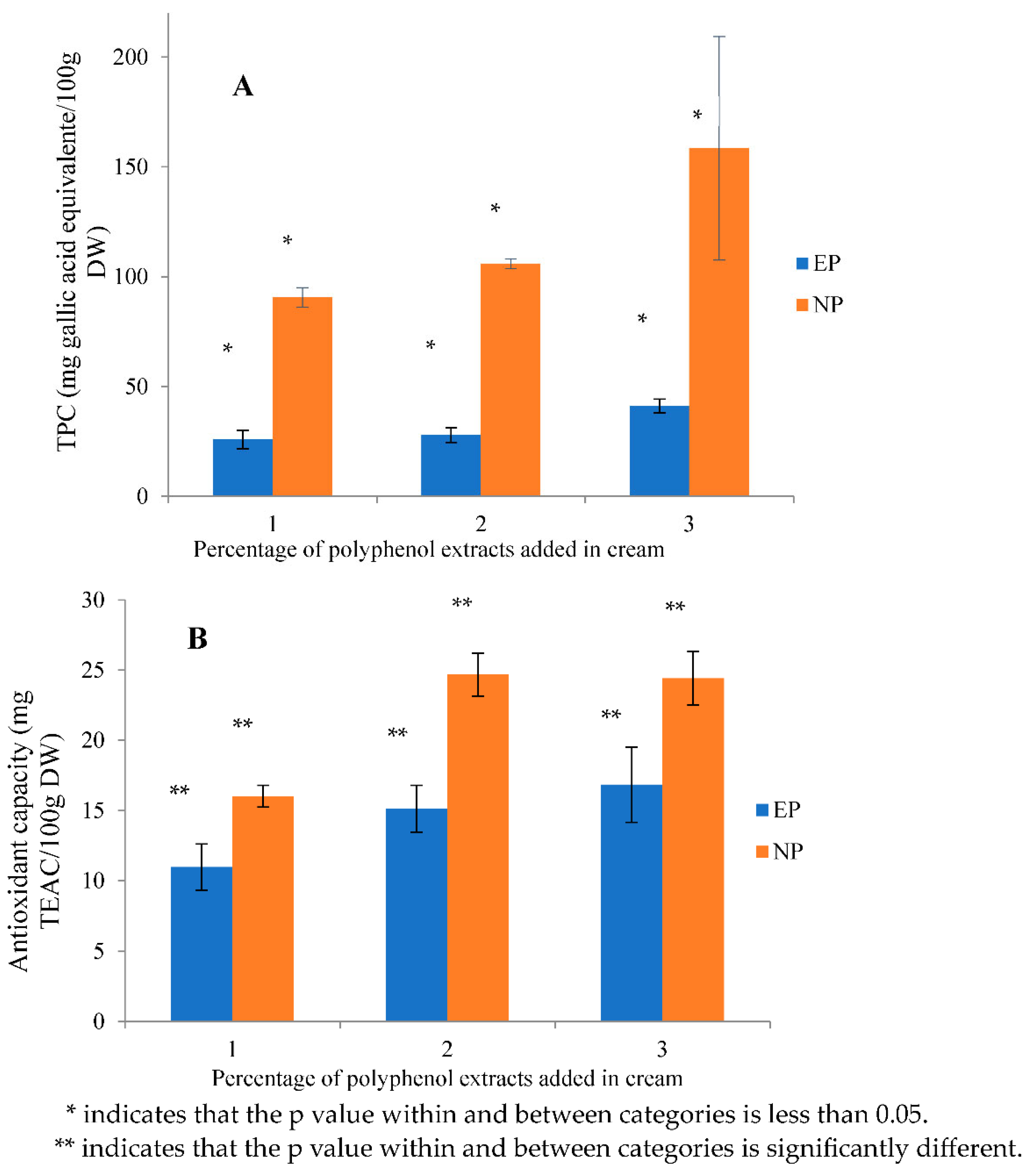
| BSA Mixture | CA | KR | PR | DR |
|---|---|---|---|---|
| n (binding sites) | 3.61 | 4.06 | 3.86 | 5.10 |
| Ka | 0.80 | 0.90 | 1.12 | 1.18 |
| Ka (106 ) | 6.33 | 7.97 | 13.24 | 15.25 |
| % Polyphenols | Z Average (d. nm) | D [3, 2] (nm) | |
|---|---|---|---|
| Control group | 0 | 1689 a ± 333 | 1688.84 a ± 332.87 |
| Non encapsulated | 1 | 4418 b ± 1204 | 4418.67 b ± 1204.77 |
| 2 | 3362 c ± 886 | 3362.89 c ± 886.14 | |
| 3 | 1970 d ± 191 | 1969.63 d ± 191.16 |
| Concentration of Polyphenols (μg/mL) | % Polyphenols Added | |||||||
|---|---|---|---|---|---|---|---|---|
| Control Group | Non-Encap 1% | Non-Encap 2% | Non-Encap 3% | Encap 1% | Encap 2% | Encap 3% | ||
| Phenolics | Chlorogenic acid | 14.977 a ± 0.976 | 0.757 b ± 0.321 | 1.057 c ± 0.012 | 1.353 d ± 0.063 | 0.263 e ± 0.009 | 0.375 f ± 0.035 | 0.484 g ± 0.035 |
| Kaempferol-3-rutinoside | 7.722 a ± 0.431 | 0.186 b ± 0.008 | 0.399 c ± 0.012 | 0.567 d ± 0.017 | 0.079 e ± 0.006 | 0.175 f ± 0.004 | 0.238 g ± 0.022 | |
| Anthocyanin | Delphinidin-3-rutinoside | 81.165 a ± 2.950 | 4.403 b ± 0.223 | 8.611 c ± 0.491 | 11.283 d ± 0.540 | 0.064 e ± 0.006 | 0.039 f ± 0.0003 | 0.030 g ± 0.005 |
| Pelargonidin-3-rutinoside | 10.953 a ± 0.634 | 0.421 b ± 0.020 | 0.861 c ± 0.040 | 1.163 d ± 0.047 | 0.013 e ± 0.003 | 0.009 f ± 0.0007 | 0.007 g ± 0.0007 | |
Disclaimer/Publisher’s Note: The statements, opinions and data contained in all publications are solely those of the individual author(s) and contributor(s) and not of MDPI and/or the editor(s). MDPI and/or the editor(s) disclaim responsibility for any injury to people or property resulting from any ideas, methods, instructions or products referred to in the content. |
© 2023 by the authors. Licensee MDPI, Basel, Switzerland. This article is an open access article distributed under the terms and conditions of the Creative Commons Attribution (CC BY) license (https://creativecommons.org/licenses/by/4.0/).
Share and Cite
Liu, C.; Nguyen, B.V.; Diep, T.T.; Yoo, M.J.Y. Interaction between Bovine Serum Albumin in Fresh Milk Cream and Encapsulated and Non-Encapsulated Polyphenols of Tamarillo. Antioxidants 2023, 12, 1611. https://doi.org/10.3390/antiox12081611
Liu C, Nguyen BV, Diep TT, Yoo MJY. Interaction between Bovine Serum Albumin in Fresh Milk Cream and Encapsulated and Non-Encapsulated Polyphenols of Tamarillo. Antioxidants. 2023; 12(8):1611. https://doi.org/10.3390/antiox12081611
Chicago/Turabian StyleLiu, Chen, Bao Viet Nguyen, Tung Thanh Diep, and Michelle Ji Yeon Yoo. 2023. "Interaction between Bovine Serum Albumin in Fresh Milk Cream and Encapsulated and Non-Encapsulated Polyphenols of Tamarillo" Antioxidants 12, no. 8: 1611. https://doi.org/10.3390/antiox12081611
APA StyleLiu, C., Nguyen, B. V., Diep, T. T., & Yoo, M. J. Y. (2023). Interaction between Bovine Serum Albumin in Fresh Milk Cream and Encapsulated and Non-Encapsulated Polyphenols of Tamarillo. Antioxidants, 12(8), 1611. https://doi.org/10.3390/antiox12081611










